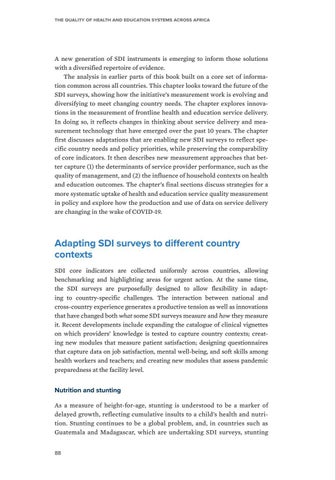The Quality of Health and Education Systems Across Africa
A new generation of SDI instruments is emerging to inform those solutions with a diversified repertoire of evidence. The analysis in earlier parts of this book built on a core set of information common across all countries. This chapter looks toward the future of the SDI surveys, showing how the initiative’s measurement work is evolving and diversifying to meet changing country needs. The chapter explores innovations in the measurement of frontline health and education service delivery. In doing so, it reflects changes in thinking about service delivery and measurement technology that have emerged over the past 10 years. The chapter first discusses adaptations that are enabling new SDI surveys to reflect specific country needs and policy priorities, while preserving the comparability of core indicators. It then describes new measurement approaches that better capture (1) the determinants of service provider performance, such as the quality of management, and (2) the influence of household contexts on health and education outcomes. The chapter’s final sections discuss strategies for a more systematic uptake of health and education service quality measurement in policy and explore how the production and use of data on service delivery are changing in the wake of COVID-19.
Adapting SDI surveys to different country contexts SDI core indicators are collected uniformly across countries, allowing benchmarking and highlighting areas for urgent action. At the same time, the SDI surveys are purposefully designed to allow flexibility in adapting to country-specific challenges. The interaction between national and cross-country experience generates a productive tension as well as innovations that have changed both what some SDI surveys measure and how they measure it. Recent developments include expanding the catalogue of clinical vignettes on which providers’ knowledge is tested to capture country contexts; creating new modules that measure patient satisfaction; designing questionnaires that capture data on job satisfaction, mental well-being, and soft skills among health workers and teachers; and creating new modules that assess pandemic preparedness at the facility level.
Nutrition and stunting As a measure of height-for-age, stunting is understood to be a marker of delayed growth, reflecting cumulative insults to a child’s health and nutrition. Stunting continues to be a global problem, and, in countries such as Guatemala and Madagascar, which are undertaking SDI surveys, stunting 88


